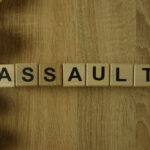Aussie Singer Charged with Assault

It was a big weekend for Australian singer Shannon Noll.
The star, who rose to fame as the runner up of Australian Idol in 2003, was involved in an incident with a bouncer outside an Adelaide nightclub in the early hours of Sunday morning, where he ended up being arrested and charged with assault.
Noll, who lives in New South Wales, was charged with two counts of assault, and released on bail.
Witnesses say the trouble started when Noll was kicked out of the Crazy Horse Revue club and began acting aggressively, repeatedly saying “I’m Shannon Noll, let me back in.”
Video footage
It’s alleged Noll punched a security guard during the altercation outside the club. Video footage shows him being pinned down by police and taken away from the scene in a police car.
The Crazy Horse Revue is a strip club, with credentials of being the ‘Home of Miss Nude Australia’.
Noll was in Adelaide to perform at the Sounds By the River music festival in Mannum on Saturday. He has won several Arias and MTV awards and, although he has not released an album since 2011, he regularly performs live gigs at festivals and has a strong internet audience.
Noll has previously admitted to having problems with alcohol and drug addiction, which he says escalated after his father died. He is adamant that he gave up drugs for the sake of his children.
The show must go on
Noll was bailed to appear at the Adelaide Magistrates Court on the 21st of February. In the meantime, his manager says the show must go on, and all of Noll’s current performing commitments will be honoured, including his appearance at the Tamworth Country Music Festival next week.
In South Australia, the offence of assault is contained in section 20 of the Criminal Law Consolidation Act 1935 (SA). In that state, an assault can occur:
- If there is any intentional and unwanted physical force used against a victim, for example, punching, hitting or kicking a person.
- If there is any intentional and unwanted direct or indirect contact with another person, however slight the contact may be, if the person committing the assault knew that the victim might reasonably object to the contact. For example, it could be throwing a newspaper at someone, knowing the person might object to that.
- Even without physical contact – for instance, if a threat is made to apply force and the victim reasonably believes that there is a possibility of the threat imminently being carried out.
- If a personaccosts (confronts) or impedes (blocks) another in a threatening way.
The offence carries a maximum penalty of 3 years’ imprisonment.
Assault charges in NSW
Assault offences in NSW are differentiated by a number of factors, including whether the act was done ‘recklessly’ or ‘intentionally’, and the extent of injury (if any) caused.
Common assault
‘Common assault’ is an offence under section 61 of the Crimes Act 1900 (NSW) which can occur without any touching at all; just causing another person to ‘apprehend immediate and unlawful violence’ is enough. Examples may include raising a fist at another in anger, or threatening to hurt or kill them in their immediate presence.
A common assault can also take place through unauthorised touching, even if the other person is not fearful for their immediate personal safety. This is called ‘battery’, and can happen even if no injuries are inflicted, or the injuries are very minor.
The maximum penalty for common assault is two years’ imprisonment.
For other types of assaults, the nature and degree of injury occasioned (caused) can be an important factor in determining the applicable maximum penalty, as well as the penalty which is ultimately imposed.
Assault occasioning actual bodily harm (AOABH)
AOABH is an offence under section 59 of the Act which carries a maximum penalty of five years’ imprisonment, or seven years if committed in the company of another person.
‘Actual bodily harm’ (ABH) is that which is more than ‘transient or trifling’; in other words, more than slight harm – such as minor redness or passing scratches – which quickly subside; Donovan [1934] 2 KB 498.
Examples of ABH may include bruises or lasting scratches or swelling; McIntyre v Regina (2009) 198 A Crim R 549 at para [44].
Transient emotions, feelings or states of mind do not amount to ABH unless there is evidence of very serious psychological harm, or psychiatric injury; Li v R [2005] NSWCCA 442 at [45]; Chan Fook (1994) 1 WLR 689.
Wounding
A ‘wounding’ is where both layers of skin are broken, namely the dermis and epidermis; Shepherd [2003] NSWCCA 351. it encompasses all cuts which penetrate into the flesh, and even a ‘split lip’; R v Hooper [2004] NSWCCA 10 at [36]
Reckless wounding is an offence under section 35 of the Act which carries a maximum penalty of seven years’ imprisonment, or ten years if committed in the company of another person.
Section 33 of the Act prescribes a maximum penalty of 25 years’ imprisonment for wounding with intent to cause grievous bodily harm.
Causing grievous bodily harm (GBH)
Recklessly causing GBH is an offence under section 35 of the Act which carries a maximum penalty of 10 years’ imprisonment, or 14 years if committed in the company of another.
Causing grievous bodily harm with intent to do so is an offence under section 33, which comes with a maximum penalty of 25 years’ in prison.
GBH covers the most serious types of injury, and has been defined by the common law as ‘really serious harm’; DPP v Smith [1961] AC 290; Haoui v R (2008) 188 A Crim R 331.
Section 4(1) of the Act says GBH includes:
- The destruction of a foetus,
- Any permanent or serious disfiguring, and
- Any grievous bodily disease.
However, this is certainly not an exhaustive list, and juries are often left to decide whether a particular injury is ‘really serious’.
The Public Defenders Sentencing Tables provide some guidance about the types of injuries considered ABH and GBH. Injuries sentenced as ABH include:
- Bleeding from head,
- Serious bruising, and
- Abrasions to shoulder and arm.
However, there are also more serious examples which could arguably amount to ‘really serious harm’, including:
- Skull and brain damage,
- Stabbings with knife, and
- Bleeding requiring stitches and broken ankle.
Injuries sentenced as GBH include:
- Fractured right arm,
- ‘Glassing’ of face requiring stitches,
- Gaping wound to face and throat requiring large number of stitches, and
- Severe facial and cranial injuries.
There is a significant overlap between ABH and GBH in so far as a particular injury may be categorised as either, and, in practice, the ultimate charge will often depend on negotiations between the parties, which frequently take into account pragmatic factors as well as the law.
That said, it should be noted that a court cannot accept a plea of guilty to a charge which is based upon ‘facts’ that clearly indicate a more serious charge; for example, that obviously amount to GBH rather than ABH; The Queen v De Simoni (1981) 147 CLR 383 at 389. The description of injuries contained in the facts may therefore need to be amended before a plea is entered.







